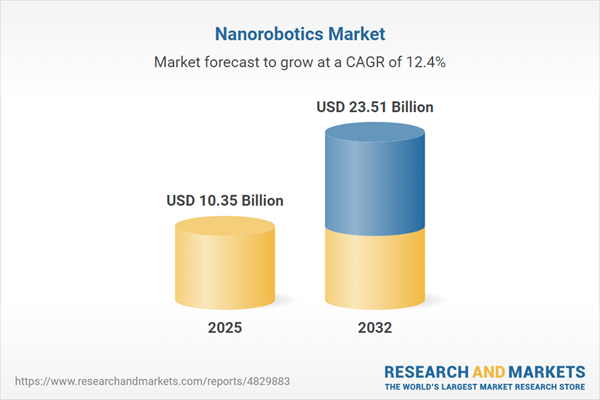Speak directly to the analyst to clarify any post sales queries you may have.
The nanorobotics market is advancing rapidly, presenting senior decision-makers with unique opportunities to boost efficiency and ensure compliance through pioneering nanoscale technologies. By integrating nanorobotics strategically, organizations are building resilience, optimizing operations, and enhancing competitiveness across multiple industries.
Market Snapshot: Nanorobotics Market Size and Growth Overview
The nanorobotics market is experiencing strong growth, propelled by increased investments in nanoscale research and expanded adoption in healthcare and manufacturing. Artificial intelligence now plays a key role in nanorobotics manufacturing, heightening automation and improving quality assurance—capabilities that are increasingly sought after by enterprises. Ongoing advancements in scientific research continue to raise industry standards, pressuring companies to update compliance protocols. Executives face evolving regulatory environments, requiring agile risk management as nanorobotics technology becomes essential to digital transformation efforts across established and emerging markets. Organizations are regularly adapting internal processes to remain agile and competitive as industry benchmarks continue to evolve.
Scope & Segmentation: Strategic Nanorobotics Market Breakdown
- Nanorobotics Types: Includes bacteria-based nanorobots, bio-nanorobots, DNA-based nanorobots, magnetically guided nanorobots, molecular nanorobots, and nano-surgery robots. These types enable high-precision surgical interventions, automation of complex industrial tasks, and secure handling of sensitive processes, broadening applications for enterprise use.
- Applications: Encompasses biomedical devices, dental technology, mechanical engineering, medical imaging, nanomedicine, surgical procedures, and targeted drug delivery. Each application supports advancements in diagnostics and facilitates minimally invasive solutions that drive efficiency across healthcare and industrial operations.
- End Users: Serves biopharmaceutical companies, hospitals and clinics, and research laboratories. Each group follows distinct procurement and operational strategies, adapting to regulatory frameworks to meet evolving enterprise needs.
- Regional Markets: Covers the Americas, Europe, Middle East & Africa, and Asia-Pacific. Leading national markets—such as the United States, China, Germany, India, and Brazil—demonstrate varied infrastructure readiness and regulatory maturity, requiring tailored strategies for compliance and competition.
- Key Industry Players: Major companies include Ginkgo Bioworks Inc., Imina Technologies SA, Oxford Instruments plc, EV Group, Thermo Fisher Scientific Inc., Zymergen Inc., Illumina Inc., Synthace Ltd., Nanotools GmbH, and Toronto Nano Instrumentation Inc., each shaping innovation, standards, and the trajectory of sector development.
Nanorobotics Market: Key Takeaways for Senior Decision-Makers
- Interdisciplinary collaboration between digital engineering, materials science, and biology accelerates nanorobotic solution deployment, enhancing enterprise readiness for both industrial and clinical settings.
- Adopting DNA-based and bio-nanorobotic systems supports organizations in achieving specialized care goals and accessing technologically advanced niche markets more effectively.
- Maintaining adaptive governance and proactive risk management ensures organizational resilience in responding to diverse international regulatory and operational demands.
- Understanding and addressing regional differences in procurement, regulations, and infrastructure builds the operational flexibility needed to manage global market uncertainty.
- Strategic supply chain partnerships and joint innovation initiatives help mitigate material shortages and enable enterprises to better anticipate geopolitical shifts.
- Aligning product portfolios with evolving technology trends and changing end-user requirements helps enterprises remain nimble and responsive as the sector advances.
Tariff Impact: United States Policy Shifts and Industry Response
Recent changes in US trade policy have increased costs for nanoscale components along the nanorobotics supply chain. In response, industry leaders are expanding supplier networks, investing in domestic sourcing, and strengthening local manufacturing. These actions support supply chain resilience and create opportunities for organizations focused on regionalized solutions, helping to offset volatility stemming from policy shifts.
Methodology & Data Sources
This assessment utilizes peer-reviewed research, active patents, real-time regulatory monitoring, and expert insights. Data triangulation and relevant case studies support the delivery of reliable, actionable intelligence as the nanorobotics market progresses.
Why This Report Matters
- Equips senior decision-makers with targeted, context-driven insights that facilitate market comparison and informed planning amid shifting risk landscapes.
- Delivers timely analysis on technology adoption and evolving regulatory requirements, guiding strategic decisions for investments, procurement, and partnerships.
- Provides practical recommendations that enhance adaptability and support resilient operations as the global nanorobotics environment evolves.
Conclusion
Remaining current on nanorobotics trends allows senior leaders to align compliance efforts, advance technological integration, and strengthen risk management. Proactive strategies ensure resilient performance and scalable growth as industry conditions shift.
Additional Product Information:
- Purchase of this report includes 1 year online access with quarterly updates.
- This report can be updated on request. Please contact our Customer Experience team using the Ask a Question widget on our website.
Table of Contents
3. Executive Summary
4. Market Overview
7. Cumulative Impact of Artificial Intelligence 2025
Companies Mentioned
The companies profiled in this Nanorobotics market report include:- Ginkgo Bioworks Inc.
- Imina Technologies SA
- Oxford Instruments plc
- EV Group
- Thermo Fisher Scientific Inc.
- Zymergen Inc.
- Illumina Inc.
- Synthace Ltd.
- Nanotools GmbH
- Toronto Nano Instrumentation Inc.
Table Information
| Report Attribute | Details |
|---|---|
| No. of Pages | 185 |
| Published | October 2025 |
| Forecast Period | 2025 - 2032 |
| Estimated Market Value ( USD | $ 10.35 Billion |
| Forecasted Market Value ( USD | $ 23.51 Billion |
| Compound Annual Growth Rate | 12.4% |
| Regions Covered | Global |
| No. of Companies Mentioned | 11 |









